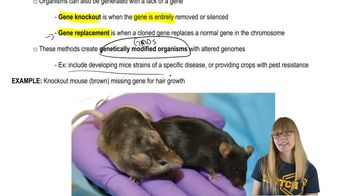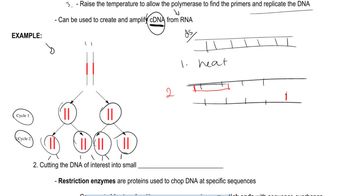Table of contents
- 1. Introduction to Genetics51m
- 2. Mendel's Laws of Inheritance3h 37m
- 3. Extensions to Mendelian Inheritance2h 41m
- 4. Genetic Mapping and Linkage2h 28m
- 5. Genetics of Bacteria and Viruses1h 21m
- 6. Chromosomal Variation1h 48m
- 7. DNA and Chromosome Structure56m
- 8. DNA Replication1h 10m
- 9. Mitosis and Meiosis1h 34m
- 10. Transcription1h 0m
- 11. Translation58m
- 12. Gene Regulation in Prokaryotes1h 19m
- 13. Gene Regulation in Eukaryotes44m
- 14. Genetic Control of Development44m
- 15. Genomes and Genomics1h 50m
- 16. Transposable Elements47m
- 17. Mutation, Repair, and Recombination1h 6m
- 18. Molecular Genetic Tools19m
- 19. Cancer Genetics29m
- 20. Quantitative Genetics1h 26m
- 21. Population Genetics50m
- 22. Evolutionary Genetics29m
18. Molecular Genetic Tools
Genetic Cloning
Problem 9b
Textbook Question
Textbook QuestionChimeric gene-fusion products can be used for medical or industrial purposes. One idea is to produce biological therapeutics for human medical use in animals from which the products can be easily harvested—in the milk of sheep or cattle, for example. Outline how you would produce human insulin in the milk of sheep.
 Verified Solution
Verified SolutionThis video solution was recommended by our tutors as helpful for the problem above
Video duration:
2mPlay a video:
Was this helpful?
Key Concepts
Here are the essential concepts you must grasp in order to answer the question correctly.
Gene Cloning
Gene cloning is a molecular biology technique used to create copies of a specific gene. This process involves isolating the gene of interest, such as the human insulin gene, and inserting it into a vector, typically a plasmid. The vector is then introduced into a host organism, allowing it to express the gene and produce the desired protein.
Recommended video:
Guided course

Positional Cloning
Transgenic Animals
Transgenic animals are genetically modified organisms that have had a foreign gene inserted into their genome. In the context of producing human insulin in sheep, the sheep would be engineered to carry the human insulin gene, enabling them to synthesize insulin in their milk. This approach leverages the natural lactation process to harvest the therapeutic protein efficiently.
Recommended video:
Guided course

Transgenic Organisms and Gene Therapy
Protein Harvesting and Purification
Protein harvesting and purification involve extracting and refining proteins from biological sources for therapeutic use. After the transgenic sheep produce milk containing human insulin, the insulin must be separated from the milk and purified to ensure it is safe and effective for human use. This process typically includes techniques such as centrifugation, filtration, and chromatography.
Recommended video:
Guided course

Proteins

 7:43m
7:43mWatch next
Master Genetic Cloning with a bite sized video explanation from Kylia Goodner
Start learningRelated Videos
Related Practice


